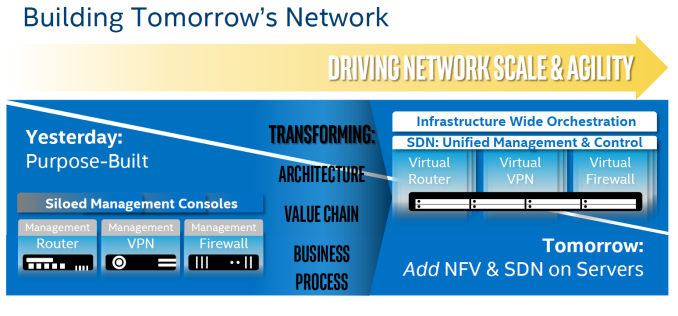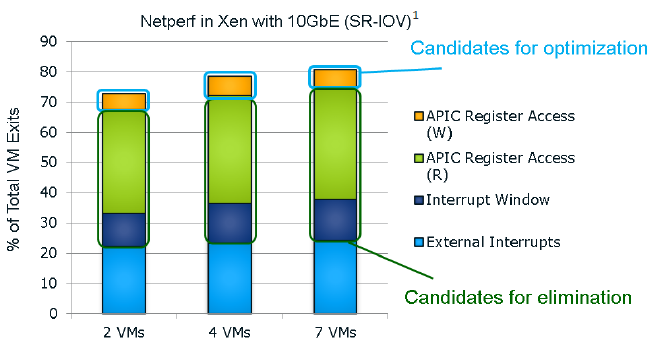The Intel Xeon E5 v4 Review: Testing Broadwell-EP With Demanding Server Workloads
by Johan De Gelas on March 31, 2016 12:30 PM EST- Posted in
- CPUs
- Intel
- Xeon
- Enterprise
- Enterprise CPUs
- Broadwell
TSX
TSX or Transactional Synchronization Extensions is Intel's cache-based transactional memory system. Intel launched TSX with Haswell, but a bug threw a spanner in the works. Broadwell in turn got it right. The chicken is finally there, now it's time to enjoy the eggs.
Faster Virtualization
Virtualization overhead is (for most people) a thing of the past. The performance overhead with bare metal hypervisors (ESXi, Hyper-V, Xen, KVM..) is less than a few percent. There is one exception however: applications where I/O dominates. And of course, the packet switching telco applications are the prime examples. Intel, VMware and the server vendors really want to convert the telcos from their Firewall/Router/VPN "black boxes" to virtual ones using Software Defined Networking (SDN) infrastructure. To that end, Intel has continued to work on reducing the virtualization performance overhead. Virtualization overhead can be described as the number of VM exits (VM stops and hypervisor takes over) times the VM exit latency. In IO intensive application, VM exits happen frequently, which in turn leads to hard to predict and high IO latency, exactly what the telco people hate.
Intel wants to conquer the telco's datacenter by turning it into a SDN
So Intel worked on both factors. So Broadwell-DP VM exit latency is once again reduced from 500 cycles to 400.
It seems that the "ticks" also get a VM exit reduction. This slide of the Ivy Bride EP presentation gives you a very good overview of the VM exits in a network intensive application; in this case a networkd bandwidth benchmark application.
I quote from our Ivy Bridge-EP review:
The Ivy Bridge core is now capable of eliminating the VMexits due to "internal" interrupts, interrupts that originate from within the guest OS (for example inter-vCPU interrupts and timers). The virtual processor will then need to access the APIC registers, which will require a VMexit. Apparently, the current Virtual Machine Monitors do not handle this very well, as they need somewhere between 2000 to 7000 cycles per exit, which is high compared to other exits.
The solution is the Advanced Programmable Interrupt Controller virtualization (APICv). The new Xeon has microcode that can be read by the Guest OS without any VMexit, though writing still causes an exit. Some tests inside the Intel labs show up to 10% better performance.
In summary, Intel eliminated the green and dark blue components of the VM exit overhead with APICv. Broadwell now takes on the VM exits due to the external interrupts.
The technology on Broadwell-EP to do this is called posted interrupt. Essentially, posted interrupts enables direct interrupt delivery to the virtual machine without incurring a VM exit, courtesy of an interrupt remapping table. It is very similar to VT-D, which allowed DMA remapping thanks to the physical to virtual memory mapping table. Telco applications - among others - are very latency sensitive. Intel's Edwin Verplancke gave us one such example: before posted interrupts, a telco application had a latency varying from 4 to 47 (!) µsec, depending on the load. Posted interrupts made this a lot less variable, and latency varied from 2.4 to 5.2 µsecs.
As far as we are aware, KVM and Xen seem to have already implemented support for posted interrupts.













112 Comments
View All Comments
ltcommanderdata - Friday, April 1, 2016 - link
Does anyone know the Windows support situation for Broadwell-EP for workstation use? Microsoft said Broadwell is the last fully supported processor for Windows 7/8.1 with Skylake getting transitional support and Kaby Lake will not be supported. So how does Broadwell-EP fit in? Is it lumped in with Broadwell and is fully supported or will it be treated like Skylake with temporary support until 2018 and only critical security updates after that? And following on will Skylake-EP see any Windows 7/8.1 support at all or will it not be supported since it'll presumably be released after Kaby Lake?extide - Friday, April 1, 2016 - link
When MS says they are not supporting Skylake on Windows 7 DOES NOT MEAN it won't work. It just means they are not going to add any specific support for that processor in the older OS's. They are not adding in the speed shift support, essentially.For some reason the press has not made this very clear, and many people are freaking out thinking that there will be a hard break here will stuff will straight up not work. That is not the case.
Broadwell has no new OS level features over Haswell (unlike Skylake with speed shift) so there is nothing special about Broadwell to the OS. As the poster above mentions, they are all x86 cpu's and will all still work with x86 OS's.
The difference here is between "Fully Supported" and Compatible. Skylake and even Kaby Lake will be compatible with WIndows 7/8/8.1.
aryonoco - Friday, April 1, 2016 - link
Johan, this is yet again by far the best Enterprise CPU benchmark that's available anywhere on the net.Thank you for your detailed, scientific and well documented work. Works like this are not easy, I can only imagine how many man hours (weeks?) compiling this article must have taken. I just want you to know that it's hugely appreciated.
JohanAnandtech - Friday, April 1, 2016 - link
Great to read this after weeks of hard work! :-Dfsdjmellisse - Friday, April 1, 2016 - link
hello, i want to buy E5-2630L v4any one can give me website for buy it ?
Best regards
HrD - Friday, April 1, 2016 - link
I'm confused by the following:"The following compiler switches were used on icc:
-fast -openmp -parallel
The results are expressed in GB per second. The following compiler switches were used on icc:
-O3 –fopenmp –static"
Shouldn't one of these refer to icc and the other to gcc?
JohanAnandtech - Friday, April 1, 2016 - link
Pretty sure I did not mix them up. "-fast" does not work on gcc neither does -fopenmp work on icc.patrickjp93 - Friday, April 1, 2016 - link
Um, wrong and wrong. -Ofast works with GCC 4.9 and later for sure. And -fopenmp is a valid ICC flag post-ICC 13.JohanAnandtech - Saturday, April 2, 2016 - link
"-fast" is a typical icc flag. (I did not write -"Ofast" that works on gcc 4.8 too)extide - Friday, April 1, 2016 - link
Johan, if you read the comment, you can see that you mention icc for BOTH.